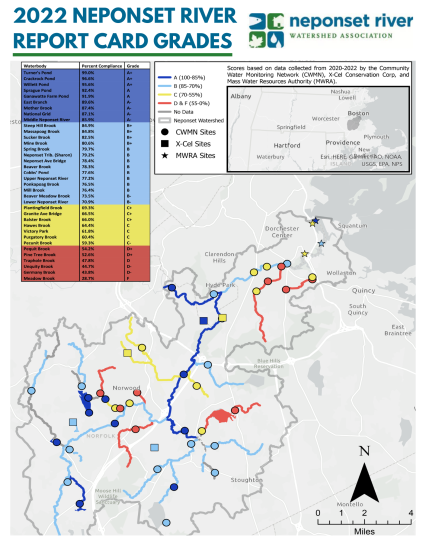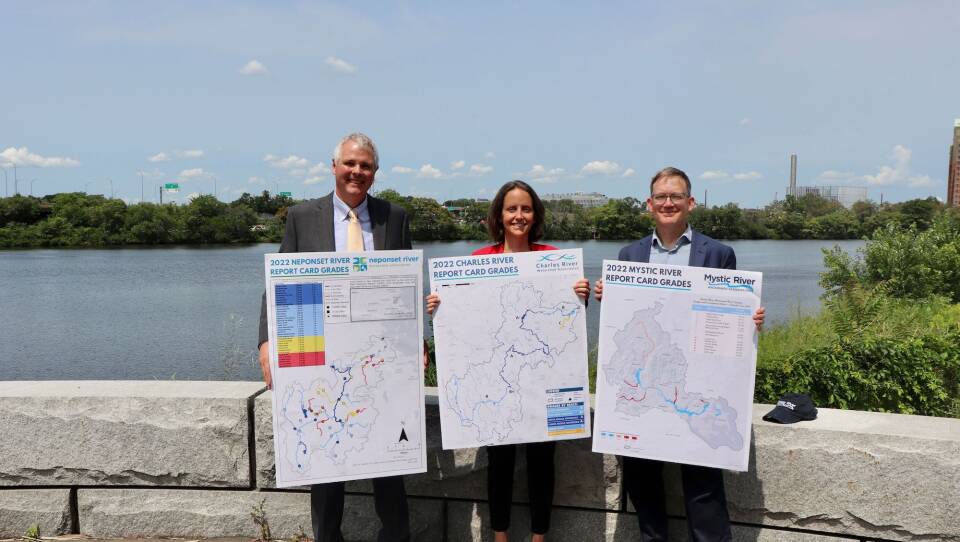A new EPA report card gives mixed grades for the water quality of the three rivers flowing into Boston Harbor, with some smaller tributaries receiving Ds and Fs as a result of sewage overflows and cyanobacteria blooms.
The water quality assessments are based on measurements of E. coli bacteria concentrations in the three watersheds over the last three years, as well as cyanobacteria blooms and combined sewer overflow discharges in the Charles River.
"We have made great progress in helping to keep our waterways clean," U.S. Sen. Ed Markey said at an event announcing the grades along the Charles River in Cambridge. "But this report card says we still have a long way to go, especially since we're being challenged by climate change."
The report card says extreme weather fluctuations linked to climate change have been impacting water quality in the watersheds. In 2021, record precipitation caused over 126 million gallons of sewage and storm water to be discharged into the Charles River. The following year, a severe drought caused the Charles to nearly run dry in places.

Emily Norton, executive director of the Charles River Watershed Association, said urban areas along the river's path have worse water quality because they have more polluted stormwater runoff and combined sewer overflows. She said the river is in better shape than it was in the mid-1990s — when the EPA launched the "Clean Charles Initiative" and former Gov. Bill Weld famously jumped into the dirty water — but progress has stalled in recent years.
"People keep asking us: 'If Paris can make the Seine swimmable for the summer 2024 Olympics, why can't we swim in the Charles?' And frankly, it's a good question. The Clean Water Act, passed in 1972, called for fishable, swimmable rivers by 1983," Norton said.
The report generally gives good grades for water quality in the Mystic River, but several tributaries rated poorly as a result of sewage contamination. Mill Creek flunked, and Alewife Brook and the Malden River got a grade of D.

Markey noted that as a child, he was told by his mother not swim in the Malden River, because it wasn't clean enough. The new report gave that river a D grade.
"So not enough has changed for those kids in Malden since the days when I was growing up there," Markey said. "And that's why I urge all of our partners here to continue working together to secure healthy and safe watersheds for everyone."
"We should all be leaning in for the next 20 years of work," said Mystic River Watershed Association Executive Director Patrick Herron. "It's going to require a tremendous investment, a billion dollars of investment to actually have a clean waterway that we can all swim in and boat in."
The lakes and ponds of the Neponset River watershed also rank well for water quality. But, like the Mystic River watershed, the effects of both drought and increased precipitation have had a negative impact on smaller tributaries.

"One of the things that is really clear from this year's data is the imprint of climate change on the results we're seeing," said Neponset River Watershed Association Executive Director Ian Cooke. "This year we looked at three years' worth of data to compose the grades. One of those was a severe drought year. Two of them were very wet years."
Those intense downpours, Cooke said, have shifted what pollutants are harming our waterways.
"Many of our lakes now are much more governed by fertilizer pollution and algae blooms in terms of their usability than they are the traditional bacteria indicator that we usually look at," he said. "So definitely we need to do what we can to try to bend the curve on the future of climate change."
The water quality assessments are based on samples collected by hundreds of volunteers for the three watershed associations. Those samples are analyzed by the Massachusetts Water Resources Authority, which reports the results to the EPA.





